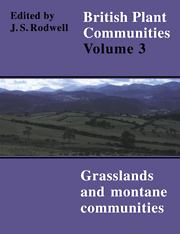Book contents
- Frontmatter
- Contents
- List of Figures
- Preface and Acknowledgements
- Preamble
- Mesotrophic Grasslands
- Community Descriptions
- Calcicolous Grasslands
- Community Descriptions
- Calcifugous Grasslands and Montane Communities
- Community Descriptions
- Index of Synonyms to Grasslands and Montane Communities
- Index of Species in Grasslands and Montane Communities
- Bibliography
U17 - Luzula Sylvatica-Geum Rivale Tall-Herb Community
Published online by Cambridge University Press: 04 July 2020
- Frontmatter
- Contents
- List of Figures
- Preface and Acknowledgements
- Preamble
- Mesotrophic Grasslands
- Community Descriptions
- Calcicolous Grasslands
- Community Descriptions
- Calcifugous Grasslands and Montane Communities
- Community Descriptions
- Index of Synonyms to Grasslands and Montane Communities
- Index of Species in Grasslands and Montane Communities
- Bibliography
Summary
Synonymy
Ledge vegetation Smith 1911a p.p., Ratcliffe 1960, Edgell 1969; Luzula-Angelica-Rumex Community Spence 1960; Luzula-Dryopteris, Luzula-Deschampsia fluexuosa-Rhinanthus and Luzula-Blechnum-Solidago Communities Spence 1960; T all-herb nodum McVean & Ratcliffe 1962, Prentice & Prentice 1975; Deschampsietum caespitosae alpinum McVean & Ratcliffe 1962; Sedum rosea-Alchemilla glabra Association Birks 1973; Luzula sylvatica-Silene dioica Association Birks 1973; Cliff ledge communities Jermy & Crabbe 1978; Saxifraga aizoides-Festuca-Deschampsia nodum Huntley 1979; Alchemilla glabra-Sedum rosea nodum Huntley 1979.
Constant species
Angelica sylvestris, Deschampsia cespitosa, Geum rivale, Luzula sylvatica, Rhodiola rosea, Hylocomium splendens.
Rare species
Alchemilla filicaulis ssp. filicaulis, Carex atrata, C. rupestris, C. vaginata, Cerastium alpinum, Draba incana, Epilobium alsinifolium, Meconopsis cambrica, Orthilia secunda, Poa alpina, P. glauca, Polystichum lonchitis, Potentilla crantzii, Salix lanata, S. lapponum, S. myrsinites, S. reticulata, Leptodontium recurvifolium, Mastigophora woodsii, Oxystegus hibernicus, Plagiochila carringtonii, Scapania ornithopodioides.
Physiognomy
The Luzula sylvatica-Geum rivale community takes in varied and often species-rich assemblages of plants, among which taller and bulkier herbs predominate, frequently making luxuriant growth and giving the vegetation the appearance of ‘hanging gardens’ disposed over the ledges and crags that provide the typical habitat. Stands are commonly of irregular shape, often small and fragmentary, frequently with local peculiarities of floristics and structure and characteristically hard of access, all features which make it difficult to provide a comprehensive and succinct account of this vegetation, but which nevertheless themselves contribute to its highly distinctive appearance.
As in the Luzula-Vaccinium community, Luzula sylvatica is a constant plant here, often attaining big stature and flowering profusely, but it is not generally so abundant, showing consistently high cover in only one particular kind of Luzula-Geum vegetation. Indeed, there is no fixed pattern of dominance in this community, and any of the other constants, together with a number of the occasionals and sub-community preferentials, can show such local prominence as to give individual stands a peculiar stamp. Among the most frequent plants, Angelica sylvestris, Geum rivale, Rhodiola rosea, Alchemilla glabra, Filipendula ulmaria and Succisa pratensis together provide a reliable distinction from the Luzula-Vaccinium community and each can have high cover in dense patches, or they may dominate together in various mixtures, forming the bulk of lush, jumbled herbage, 3-4 dm tall.
- Type
- Chapter
- Information
- British Plant Communities , pp. 461 - 477Publisher: Cambridge University PressPrint publication year: 1992

